Compare Trello vs Jira: The Best Project Management App for your Team in 2023

Can’t decide between Jira and Trello? At first glance, these project management tools may offer the same features such as kanban boards, time tracking features, integrations, mobile apps, browser extensions, and more.
Instead of making a random pick or going through each tool for a period of time, why not evaluate each product through an identified criteria? This will make it easier for you to make an informed decision about your next project management solution.
Choosing a Project Management Software
There are a lot of factors to consider when choosing the right software or solution for your project or team. With so many challenges to project management and a lot of popular project management tools to choose from, you might end up not getting the option you might think is the best fit for your needs.
Avoid wasting your time and money by considering the following factors when choosing the right project management tool:
- Usability
- Collaborative Capabilities
- Customizability
- Pricing
Familiarizing yourself with these factors along with the needs of your role, team, and project is crucial to finding the best project management app. Jira and Trello are some of the most popular management platforms available online. Both of these tools may have similar features and functions but can offer various advantages and disadvantages depending on your needs and requirements.
We’re also going to suggest a third tool that can save you even more time and money! Let’s take a look at each tool’s individual pros and cons to find the best fit for you!
What is Jira
Jira is a powerful bug tracking and project management software. It offers tools to help software teams sketch out a roadmap for big and complex projects. Teams who are looking to follow a scrum, kanban, or any other Agile methodologies can find support from Jira. Jira is an Agile project management tool provides each user with access to comprehensive agile reporting to give them actionable insights to how each team performs during each sprint.
ClickUp vs Jira: Which is the better option?
Best Features
- Support for Scrum, Kanban, and any framework in between
- Intuitive interface makes it easier for anyone to access the tool
- Customizable workflows, reports, and boards
Limitations
- Lack of collaboration tools to communicate with distributed teams
- Software can be clunky and slow
Pricing
- Free for 10 users
- Standard: $7.75 per user
- Premium $15.25 per user
- Enterprise: Contact sales for pricing
User Ratings
G2: 4.2/5 (5000+ reviews)
Capterra: 4.4/5 (12700+ reviews)
“Jira helps organizing the engineering team to be on top of their tasks every sprint and to have transparency into what everyone is working on at a given point in time. It is also a great platform to integrate with many other parts of the tech stack such as Slack, Bitbucket, Confluence.” – Pedro D., Product Manager
What is Trello
Trello has quickly become one of the most popular and versatile tools for teams embracing the Kanban method. With its intuitive user interface, Trello makes it easy to create visually-appealing boards with different customizable lists while also supporting collaboration between team members so that everyone can see project updates as they happen. Furthermore, Trello lets you invite unlimited members and supports coordination by assigning tasks to specific team members, allowing them to add checklists, set due dates, and attach files from their computer or from cloud storage services. Trello is a a must-have tool for any team looking to implement their own version of the Kanban method/.
Best Features
- Organize projects and tasks with a board system
- Integrations with productivity tools such as Google Drive and Slack
- Mobile app allows users to access board and lists on the go
Limitations
- Not suitable for complex projects
- No way to nest cards
- Limited to 3 boards in free plan
Pricing
- Free Plan
- Standard ($5 per user/month; billed annually)
- Premium ($10 per user/month; billed annually)
- Enterprise (contact for pricing)
“Trello was a great software to get my feet wet, so to speak, when it came to getting the hang of using a project management software for my business. It definitely helped me to graduate to the next level in my ability to keep my team productive. Even as my team has grown, I have decided to keep the Trello software for the purposes of managing all of my management teams scheduling, tasks, and etc.” - Caitlyn R., Editor-In-Chief
Jira vs Trello in the Community
When looking for reliable information about Jira vs Trello, it is important to include resources from the community. This is because the community perspective offers a unique view on each of these tools, as members are unbiased and have likely used both options themselves.
Using the G2 Grid for project management software comparison is also a great way to quickly evaluate the two tools and make an informed decision. G2Crowd sources from a diverse set of user reviews to create this measurement to help potential customers compare different solutions side-by-side.
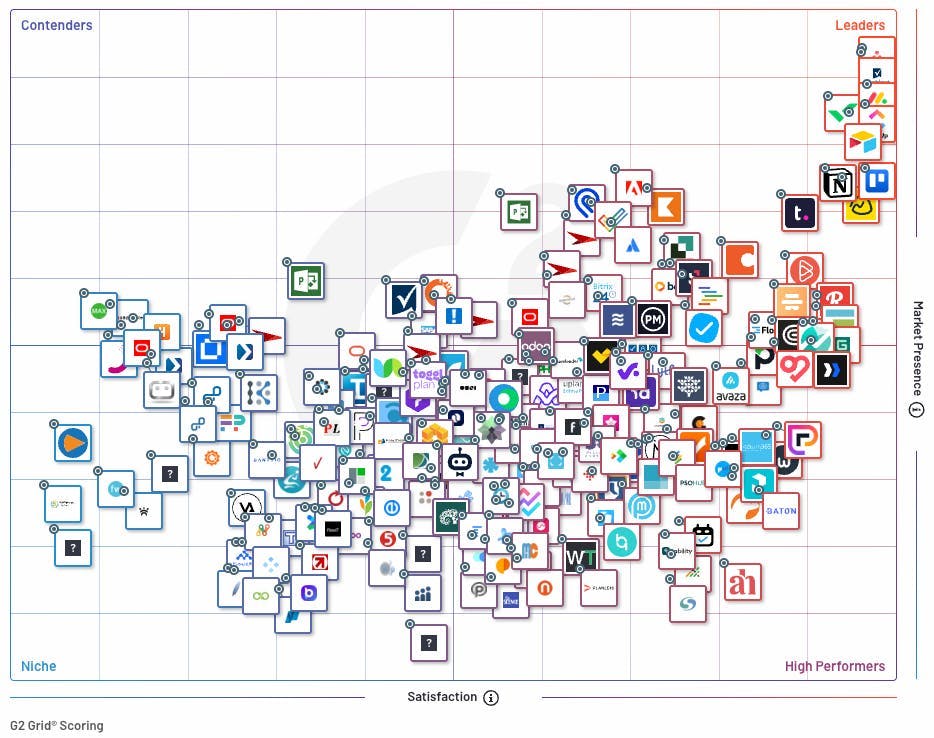
As you can see, Jira is more middle of the road while Trello can be seen near the top of the grid.
Depending on your use case, you may want to consider these scores and rankings as they are a very good reflection of current user satisfaction and an indication of future potential.
Jira vs Trello on Reddit
What better way to really get a feel for a tool than reading through what users on the internet are candidly sharing? Check out some Reddit posts on both tools.
Jira Reddit Review
“This is like asking people if they’ve had good experience with C++. You’re going to get a range of answers from great to terrible. People’s experience with Jira will depend on how it was implemented, managed, and respected within the company. There are many great examples of Jira being used successfully, and there are plenty of bad examples of Jira being abused as part of failed management systems. Personally, I prefer something more basic for most teams without dedicated project managers. Jira is a power tool with hundreds of options that can make your life worse in the wrong hands.” - via Reddit
Trello Reddit Review
“I find Trello useful for having a way to view the big picture across projects, tasks, etc that I am working on. I think the strength of Trello is that it is very simple (boards, lists, cards) and easy to use so it can be applied to just about anything where you need to organize information. It isn't a perfect 100% fit but it is often good enough and much less complex and expensive than tools focused on more narrow solution areas.” - via Reddit
Now, onto our honest opinions on different categories of comparison between Trello and Jira.
Usability and Feature Comparison
Jira's Usability and Features
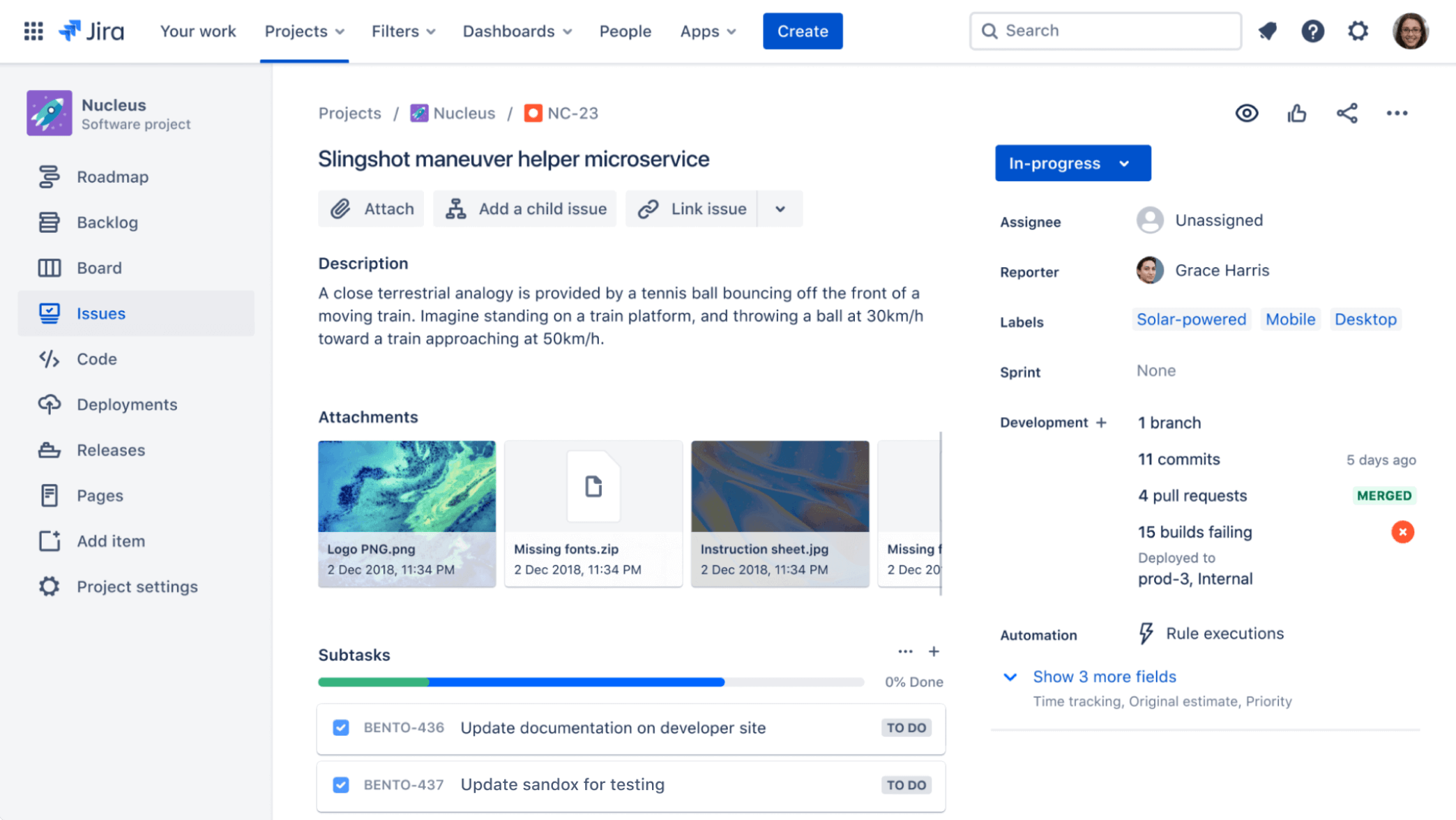
Source: Jira
Jira is an incredibly useful project management tool that enables teams to stay organized, track progress on tasks, and collaborate effectively. It's designed specifically for agile teams looking to quickly develop products with the flexibility to adjust direction as needed.
The most common usability issue is that to get Jira set up, you'll need to either have a consultant help build workflows or encounter a steep learning curve to get it implemented.
The core features of Jira include customizable workflows, flexible work organization options such as boards and sprints, real-time project tracking, and reporting tools. There are also numerous plug-ins that can be used to integrate with other popular software solutions like Slack, Salesforce, and Zendesk. With Jira's vast library of add-ons, you'll be able to find many important features a fit for your team's needs.
Jack D., a web developer says the following: “The user interface of Jira is very intuitive and familiar to what many already know from standard office suites such as Microsoft or Google. Despite this, it also contains enough advanced features for software engineers or development teams to benefit significantly from its use. This combination of both essential functions is excellent for novices with more complex options making Jira an appealing tool even in business environments. I strongly feel that Jira's user experience needs to be improved substantially to remain competitive.”
Trello's Usability and Features
Trello is an easy and free to use tool to create workspaces and boards for task management, project management, collaborations, and more in a simple and straightforward platform. The app helps users prioritize tasks and organize work to improve productivity with its simple Kanban board that you can arrange and customize with elements. Assign tasks to various users and add deadlines, labels, alerts, and important information or files to each card.
While Trello is a great platform with tools to organize and manage work, it does not feature a dedicated chat tool or video calling feature which some may find inconvenient. However, Trello can be integrated with significant third-party applications to further improve productivity.
Ashley L., a small business CEO says the following: Trello is so simple to use. It has so many features that are available in the free version. You can add users and communicate by tagging people or assigning tasks. It's visually helpful, especially if you like to be able to see how tasks are organized. You can have multiple boards which are essentially spaces for your different projects.
A Project Management Tool with Better Features and Usability
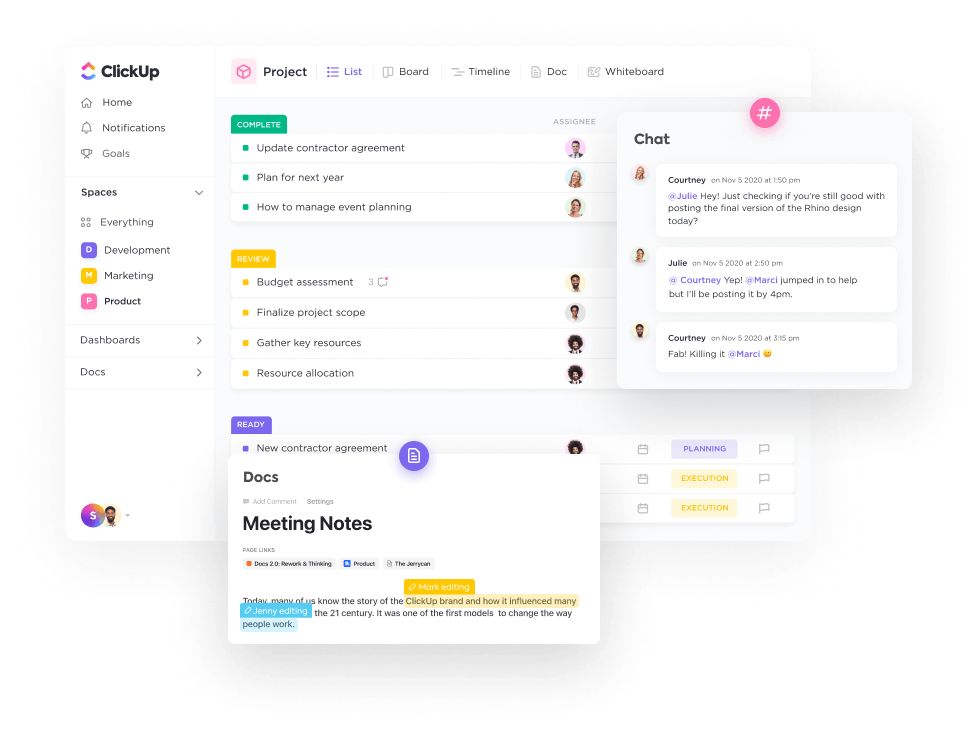
Before you limit yourself to just these two tools, you might want to throw our favorite, ClickUp, into the mix. While both Trello and Jira are great tools in terms of features and usability, ClickUp is one of the top project management software solutions available. Regardless of getting a free or paid plan, you are able to enjoy better functionality than the paid versions of both Jira and Trello.
Search your entire Workspace to find tasks, Docs, Whiteboards, and more with ClickUp’s advanced search. With hundreds of flexible tools, drag-and-drop functionality, and over 1,000 integrations to streamline your workflows, ClickUp takes your productivity to new heights.
Check out ClickUp’s multiple features.
Collaborative Capabilities Comparison
Jira's Collaborative Capabilities

Source: Jira
Jira makes it easy to stay in sync with team members, no matter where they are located. With its built-in chat function and integration with popular messaging apps like Slack, you can keep everyone informed of progress on tasks or changes in the project's direction quickly and effectively.
Compared to other tools, Jira stands out for its ability to coordinate tasks between engineering teams and other departments in an organization. Its intuitive interface allows engineers to quickly see who has responsibility for a specific project and what tasks are due.
Holly M., Omnichannel Ordering Performance Manager, says this about Jira's collaboration features: Jira is relatively easy to use to make projects, sprints and create a backlog of issues to be completed. Easy to collaborate with tech teams and link issues together that are associated.
Trello's Collaborative Capabilities
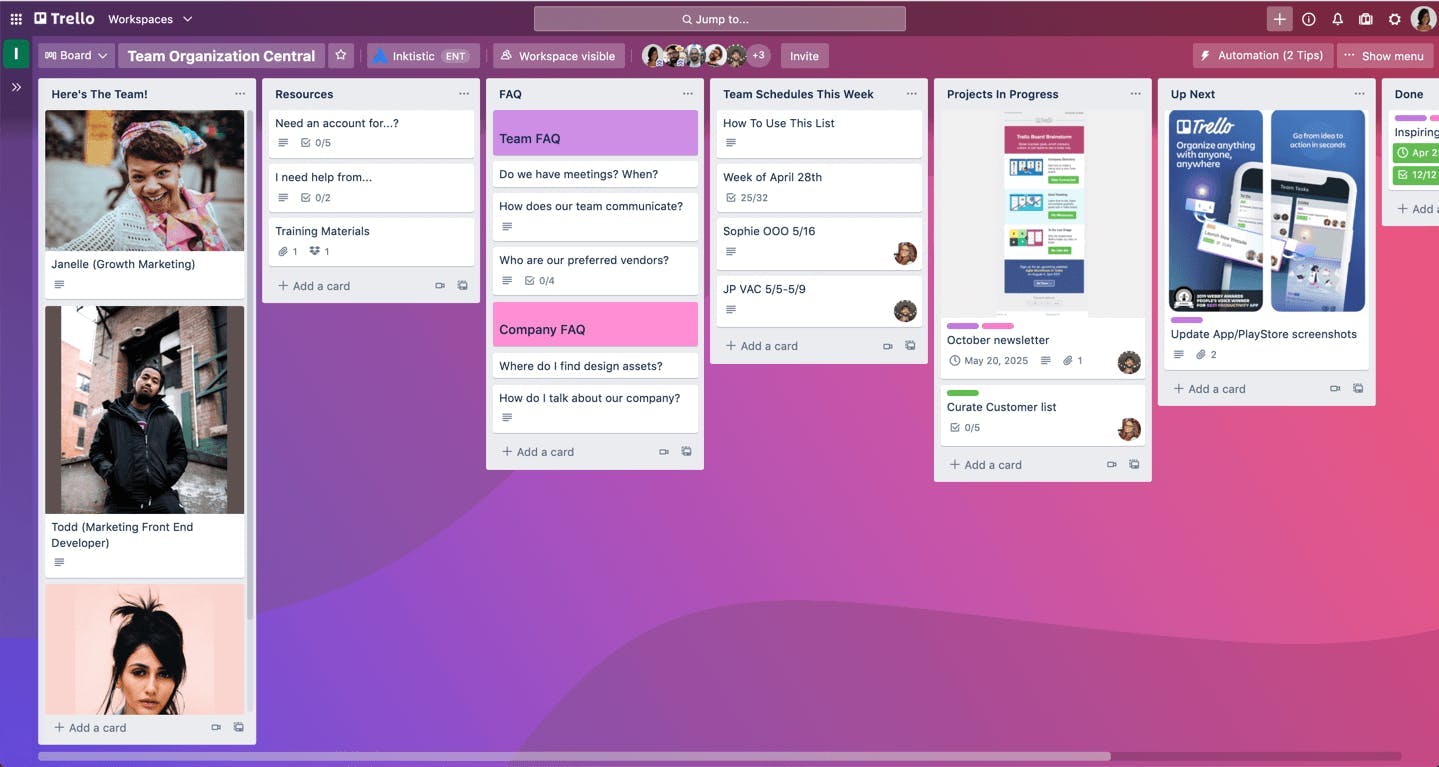
Source: Trello
Trello is a great way to maintain a smooth collaboration between you and other users when working on important projects. Invite them to a dedicated Trello board for each project for a robust communication process. Each member of the team can create tasks and keep track of their progress. Trello’s structure may be too simplistic if not managed well. With full use of each card’s functionality, users are able to fully utilize Trello as a collaboration tool.
Karrie B. says this about Trello’s collaboration features: Overall, I simply love Trello. I use it for every client that I work and most of them start their boards as well when they see how easy it is to use. Works as a great communication tool for the team and is a great way to document processes and flows within the organization. The ability to move cards between lists and boards allows you to really keep track of a process without getting overwhelmed.
Next Level Real-Time Collaboration with ClickUp
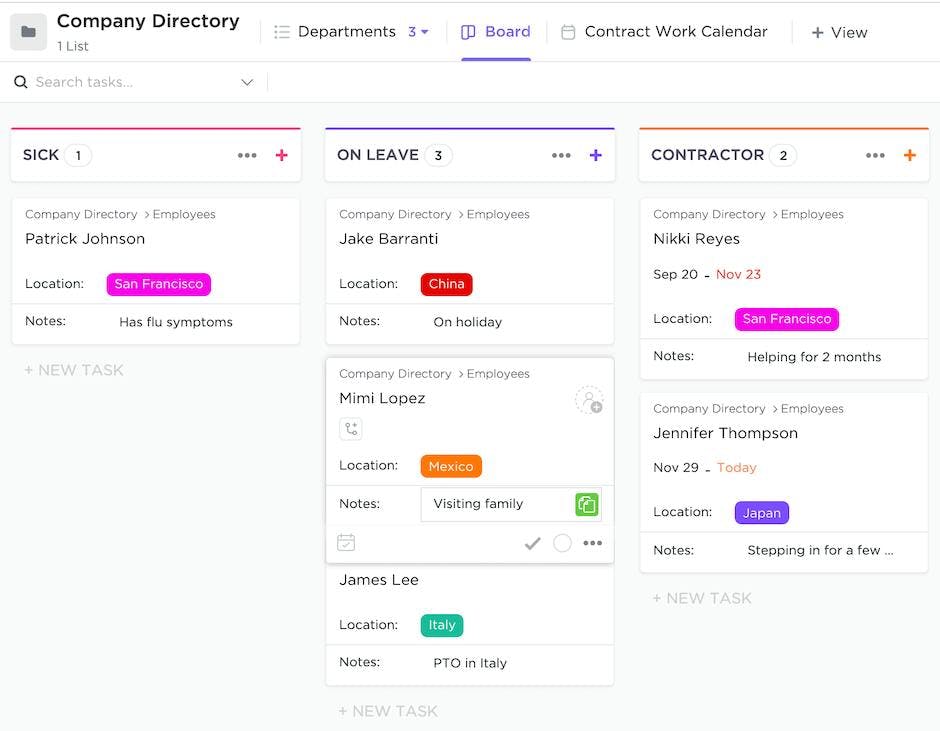
If you’re looking to keep your hybrid, remote, and in-office teams connected and working together efficiently, ClickUp can do the job, and do the job better.
ClickUp's collaboration features make it an ideal choice for distributed teams and remote work. Its wide range of features allows users to communicate quickly and effectively, no matter where they are located.
ClickUp's Chat View is also an incredibly useful feature that allows users to communicate and brainstorm easily in a specific List or Folder without having to switch between different applications. There's also an in-built Calendar feature that syncs with Google and Outlook calendars to help team members decide on important dates and team meetings.
Our idea of a great choice for team leaders and project managers. Just sayin’!
Learn more about the types of teams that ClickUp can support.
Customization and Scalability Comparison
Jira's Customization and Scalability
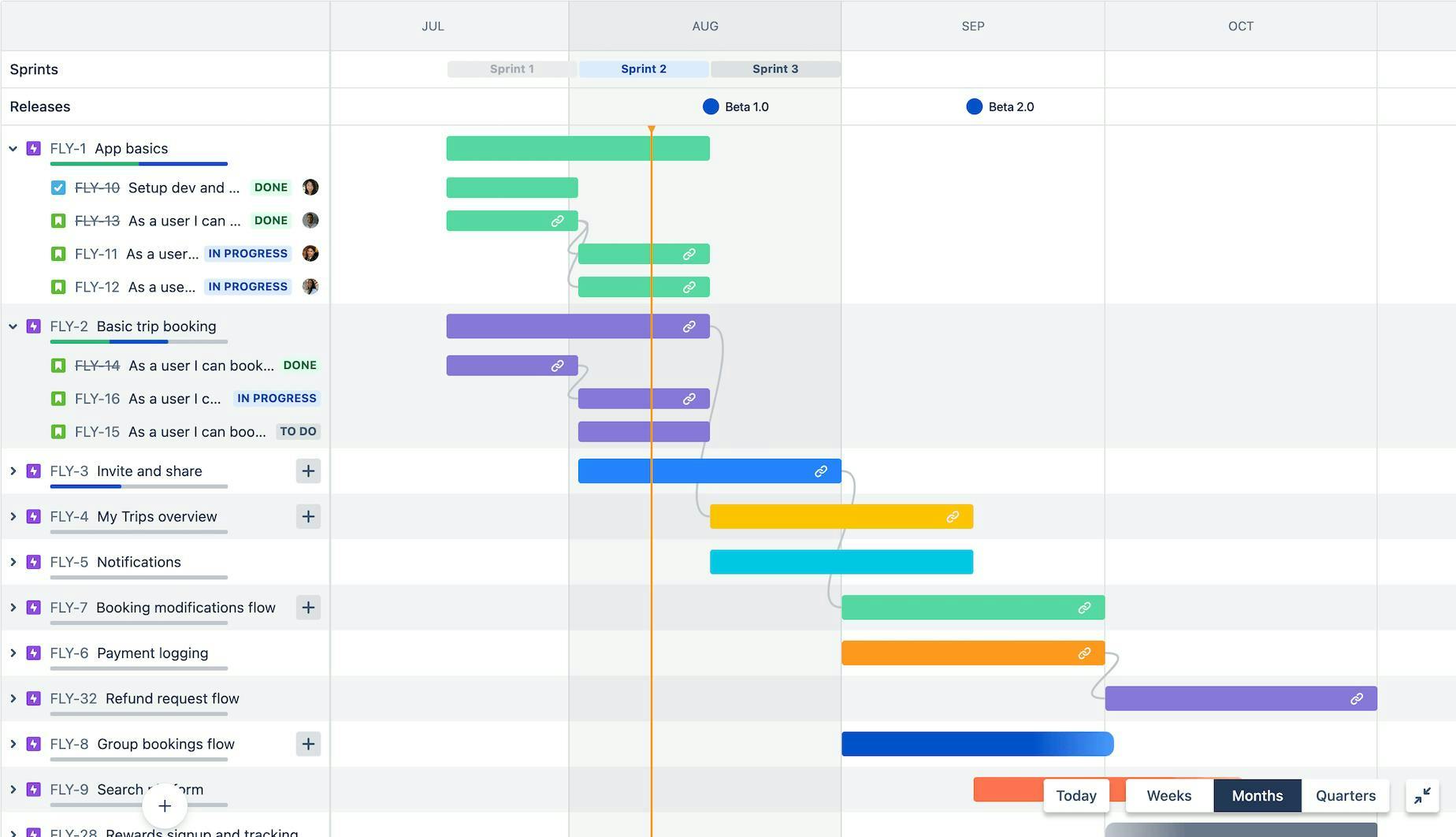
Source: Jira
Jira is a versatile and customizable platform that can easily be adapted to meet the needs of your team. With a robust set of APIs, developers can easily create custom applications and integrations to get the most out of their Jira instance. From software development teams to customer support departments, Jira is an invaluable tool for streamlining processes and keeping projects organized.
Teams can customize their workflow via drag-and-drop tools, quickly build custom reports and dashboards to track progress, and collect powerful analytics for insights into their data.
For larger teams and organizations, Jira provides advanced features such as flexible access levels, multiple project templates, and automated workflows for streamlined collaboration across the organization.
Liam M., VP of Product Management raves: “Without a doubt, Jira's best feature is the ability to customize it to your organization. Jira helps our company stay aligned on all projects and work in the pipeline, ensuring everyone is rowing in the same direction. [The tool] feels like a solid partner that can scale infinitely as our company grows, so we don't have to worry about 'outgrowing' it.”
Trello's Customization and Scalability
Trello is a simple platform featuring a Kanban board that you can personalize according to you and your team’s needs and preferences. Lists and cards can be moved in between boards which are great for bigger teams or businesses with multiple departments.
Integrate the tool with third-party apps to extend functionality which may be needed in complex projects. Regardless of its simplicity, it can be customized to work even for an Agile team with external plugins or an enterprise plan.
Yenireth Rozo comments: Trello is an excellent tool to organize and take control of the daily activities that must be carried out and sometimes of projects that must be carried out in certain periods. You can customize, place, colors, time, and small activities within the main ones.
Consider ClickUp’s Highly Customizable and Scalable Tool for Your Team

Take ClickUp’s massive feature set, collaboration and customizability, and put it together. You get scale. ClickUp's rich set of fully customizable features is ideal for aligning each team member, working together, and delivering high-quality products on time and on budget. The tool can be customized as a personal board or a resource management tool. It also offers templates for personal and project use including a variety of to-do list templates.
Its scalability is enabled by the multi-dimensional structure - for instance, ClickUp’s organizational hierarchy allows users to structure their workspace in whatever way works best for them. ClickUp also offers extensive reporting capabilities which can be adjusted depending on the size of an organization.
This makes it a great solution for organizations of all different sizes and types that are looking for an intuitive yet powerful management tool.
Cost Comparison
Jira's Pricing

Source: Jira
When it comes to pricing, Jira is on the steeper side. Depending on the version, the cost of Jira ranges from $10 - $50 per user per month. But, it's also worth noting that Jira offers discounts for non-profits, educational institutions, and more.
Jira also offers a free version that allows up to 10 users to use the service at no cost. This includes basic features such as task customization, time tracking, and reporting. However, the free version does not offer more advanced features like Agile project planning or Integration with other services.
For a more enterprise organization, you can upgrade to higher plans that also include access to advanced features like Jira Service Desk and integration with other services.
Pratik J., software engineer mentions this about pricing: “It is a bit more expensive than other similar tools, but if you have large number of users in your company or project, the price will definitely be worth it for sure.”
Trello's Pricing

Source: Trello
Trello has a free version where users can manage and create multiple projects but may lack advanced features for complex and bigger projects. The free version includes 10 boards per workspace and other basic features and commands. The Standard plan starts at $5 per user/month with unlimited boards, custom fields, and 1,000 commands per month.
Bigger teams with multiple projects can upgrade to a Premium plan starting at $10 per user/month. This plan comes with additional workspace views, security features, unlimited command runs, and more. Enterprises may contact sales for a custom plan with advanced integrations and control options.
Mees J. mentions the pricing: “Trello is a great tool that helps keeping track on projects which I find easy to use. The best of all is that the core features are completely free. Trello is also extremely helpful when collaborating with others and there are plenty of features for this.”
A More Cost-Effective Plan with ClickUp
Save and get the best value for your money with ClickUp. Choose from a variety of plans ranging from the Free Forever plan to the Enterprise Plan. The Forever Free plan is perfect for small teams who need a basic project management tool and don’t require the comprehensive feature set of a premium plan.
If you need even more advanced project management features and unlimited storage, the Unlimited Plan and Business Plan provide access to powerful features such as unlimited Gantt charts, timelines and workload management. ClickUp also offers an Enterprise Plan for more complex organizations.
Get started with ClickUp today, for free!
Trello vs Jira: Bottom Line
Choose Jira if:
- You’re working with Agile software development teams
- You need to integrate with CI/CD tools for the software development lifecycle
- You're looking for more robust project management tools with reporting and statistical capabilities
Choose Trello if:
- You need a simple and easy to use project management tool
- You're looking for an application with powerups and integrations for more functionality
- You're looking to follow a Kanban approach when it comes to task management
Get All Features Combined with ClickUp
Now that you have a better idea of each of these tools’ advantages and disadvantages, you are now better equipped to make a better decision when it comes to picking the right tool for your needs.
If you’re still not sure about the best project management software that will help you achieve your project goals and team objectives, why not get an all-in-one solution like ClickUp that will allow you to grow and scale as your team gets bigger.
ClickUp offers not just project management solutions but collaboration tools, flexible views, detailed reports, and so much more all under one single application. Take advantage of organization-wide permissions to help teams align with common goals and objectives.
Save time, stay focused, and improve overall productivity by creating and customizing the perfect workspace. Choose from a library of templates to get started and handle any task or project with ease. Try ClickUp for free today and discover the best tools to improve your overall workflow and productivity all under one application.


